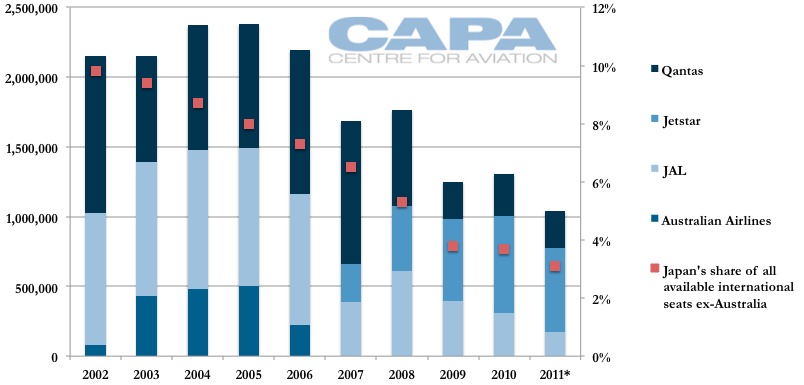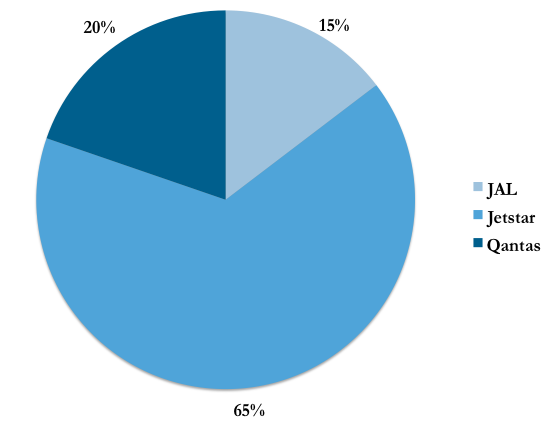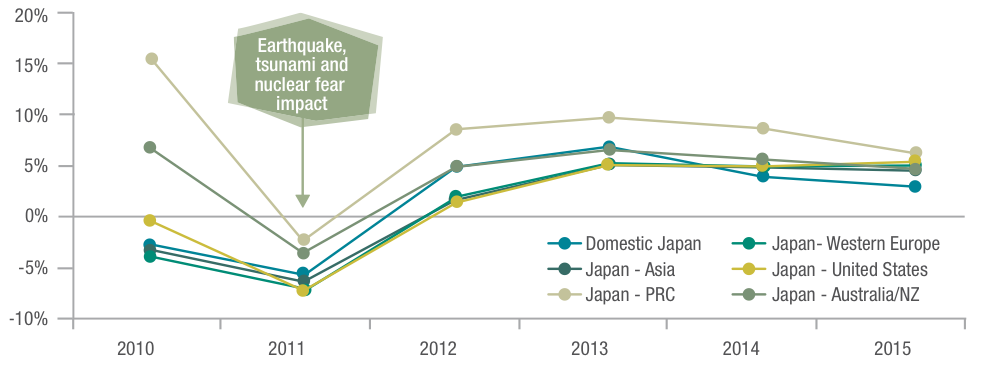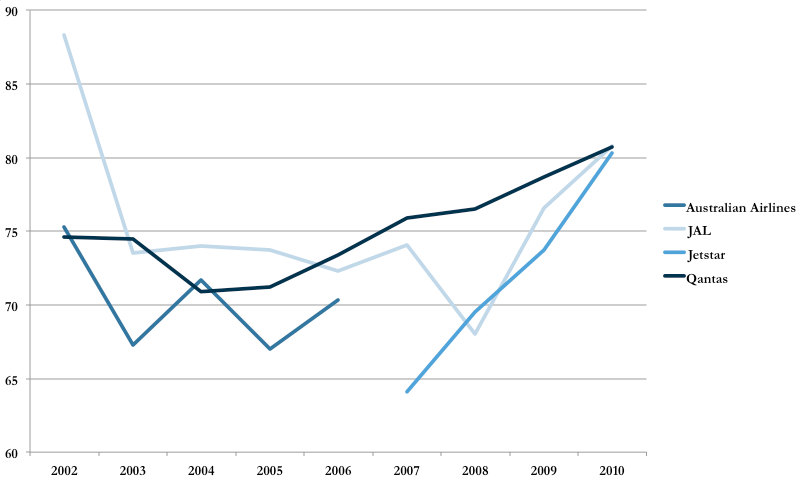Australia-Japan open skies agreement fails to gain traction in shrinking market
There is unlikely to be any short-term change to Australia-Japan air services following an open skies agreement between the two countries that gives Australian carriers access to Tokyo Haneda airport and fifth-freedom traffic rights. Qantas serves Tokyo Narita and has been given nonviable midnight slots at Haneda, and furthermore its low-cost arm Jetstar - the largest operator in the market - is establishing a subsidiary at Narita. The liberalisation comes as the Australia-Japan market continues to shrink, with traffic down 56% from its 2005 peak, making Japan Australia's largest shrinking market.
The Australian government announced with great fanfare the open skies agreement with Japan, proclaiming it "landmark". Japan last month concluded an open skies agreement with Canada and is working on a similar agreement with Taiwan.
Market liberalisation despite slow demand
Under the agreement with Australia, air services - previously subject to a bilateral agreement - will be liberalised. Australian carriers will be able to serve Tokyo Haneda airport, conveniently located near downtown as opposed to Tokyo Narita, an hour outside of the city. Capacity restrictions at all airports will be lifted, save for restrictions at Tokyo Narita, which will be lifted from 2013 as the airport increases capacity with terminal expansion; the 250,000 annual slots at Narita in FY2012 will increase to 300,000 in FY2014.
Yet the liberalisation comes as demand continues to slow for services between Australia and Japan. Thanks to decreasing trade and investment between the two countries and the global financial crisis heavily affecting Japan, traffic between the two countries has steadily fallen from 2005 levels, with the number of available seats this year - 1 million - projected to decrease 56% from the past decade's 2005 peak of 2.4 million available seats. The decrease left 22.7 weekly wide-body units of availability capacity to Australian carriers at the time of the open skies agreement. It is a sum unlikely to have been fully utilised in the foreseeable future.
Available Australia-Japan seats and its share of all international seats ex-Australia: 2002-2011*

Haneda fails to woo Qantas
While Australian carriers have been given access to a daily service from Tokyo Haneda, the slots given are for operations between the nonviable times of midnight and 6:05 am. Qantas' sole service in the market - accounting for 20% of available seats in Nov-2011 - arrives from Sydney into Tokyo Narita shortly after 6 am, making the arriving time possible under the limited Haneda slot.
The return the service departs Tokyo around 8pm to arrive in Sydney the next day at 8 am. Complying with Haneda time restrictions and offering a midnight departure would see a Sydney arrival of mid-day or early afternoon, not ideal for the corporate market. Qantas says it has "no immediate plans to fly to Haneda", but notes "the agreement is obviously a positive development". Qantas offers service to Tokyo Haneda via a convoluted codeshare with JAL that requires transferring in Singapore for a routing 48% longer than flying directly into Tokyo Narita.
Qantas' low-cost subsidiary Jetstar, the only other Australian operator in the market, serves Tokyo Narita from Cairns and the Gold Coast. Jetstar offers 66% of available seats in Nov-2011. Since Jetstar caters to the leisure, not corporate, market, it is able to increase aircraft utilisation at the expense of daytime flights the corporate market traditionally shuns. Jetstar services depart Australia during the day and arrive in Japan in the evening before quickly turning around to return to Australia. In contrast, Qantas offers an overnight service to and from Tokyo and so has its aircraft on the ground in Tokyo for 14 hours between a morning arrival and evening departure; Jetstar turnaround times are approximately 90 minutes. Jetstar's schedule of early evening arrivals and departures would not be possible at Haneda.
Japan Airlines, the only Japanese carrier serving the market, with 15% of Nov-2011's available seats, already has access to Tokyo Haneda but has elected to use its coveted slots for other services.
Projected share of available Australia-Japan seats: Nov-2011

The lack of daytime slots at Haneda for international airlines has vexed European carriers as the slots do not facilitate connections to Japan or North Asia. As Lufthansa general manager for Japan, Otto Benz, recently commented: "From the standpoint of European airlines the situation at Haneda is still very disappointing. While Japanese government strategy describes a hub concept at this airport, the reality shows that European carriers cannot benefit by two-way feed offered by Japanese carriers as EU [European Union] airlines are constrained to operate only between 2200 hours and 0700 hours. The only feasible departure time under the given time-window for a European airline from Haneda would be between 0600 hours and 0700 hours and this would mean no connectivity from other Japanese cities, whilst Japanese airlines and Asian hub carriers could easily feed their Haneda flights with their planned flight schedules."
British Airways is the only European carrier to serve Haneda, and does so with a 6:25 am departure. Aeroflot, Alitalia, Austrian Airlines, British Airways, Finnair, KLM, Lufthansa, Swiss and Virgin Atlantic all depart Tokyo Narita between 10 am and 2 pm. Air France departs shortly before 10 pm.
See related article: Airlines charging a premium for services from Tokyo Haneda
Qantas Group's strategic focus is at Narita, not Haneda
Slot times are not the only factor for the Qantas Group concerning Haneda. If viable Haneda slots were made available, the airport's advantages are its proximity to Tokyo, more onward domestic services and has so far allowed airlines to charge more for Haneda services than those at Narita.
But factors could see Qantas remain at Tokyo Narita even if viable Haneda slots were offered. A single operation at Narita offers efficiency, and Jetstar - which is projected to operate 77% of the Qantas Group's total available seats into Japan in Nov-2011 - will be at Narita in the long-term with its forthcoming Jetstar Japan subsidiary. More domestic connections will be possible at Narita as the airport by FY2014 increases domestic slots 50% to 30,000 annually and expands to 20 the number of domestic cities served from Narita, currently at eight. As no other full-service Australian carrier serves Japan, and the only non-Qantas Group carrier is oneworld partner Japan Airlines, Qantas does not have to worry about competition out of Haneda. Remaining at Narita also allows Qantas to continue offering numerous connections to the United States on services operated by American Airlines, who Qantas jointly tickets with.
Narita Airport slot increase
| Mar-2010 | FY2011 | FY2012 | FY2014 |
|---|---|---|---|
| 220,000 | 250,000 | 270,000 | 300,00 |
Jetstar Japan increases Narita's prominence
Narita's prominence in the Qantas Group will further rise by the end of 2012 when Jetstar Japan, a joint-venture between Japan Airlines, Jetstar and Mitsubishi Corp, launches from its base at Narita with a second base to follow at Osaka Kansai. Jetstar Japan domestic routes will initially cover Sapporo, Fukuoka and Okinawa, with Kagoshima, Hiroshima, Kyoto, Osaka, Nagoya and Sendai. Jetstar says it plans to operate an international network within a year from launch, covering destinations in China, South Korea and Southeast Asia, including the Philippines. Jetstar Japan will consider serving any point within the four/five hour range of Japan. Initial operations will be with three 180-seat A320s, growing to 24 within a "few" years. Jetstar has not ruled out operating any of the group's other aircraft types for its Japanese subsidiary.
See related article: Jetstar Japan to commence service by Dec-2012
Withdrawals from Perth and Brisbane remove 20% of seats
The downturn in the Australia-Japan market has been steady, and not spiked by the Mar-2011 earthquake and resulting tsunami that saw carriers globally decrease Japanese capacity. JAL in Sep-2010 withdrew its Tokyo Narita-Brisbane service, leaving a Sydney service its only Australian link. This move followed other route cancellations and capacity decreases. Qantas in May-2011, shortly after the earthquake and resulting tsunami, ended its Perth-Tokyo Narita route. These withdrawals follow previous route reductions in 2008, including Qantas' thrice-weekly Melbourne-Tokyo service and reducing by two frequencies its Sydney-Tokyo service, and JAL in 2009 down-gauging routes from a B747 to a B777-200 to Sydney and B767-300 to Brisbane.
Qantas chief executive Alan Joyce in Aug-2011 expected a full recovery in the Japanese market in Oct-2011, but did not announce a return of the Perth-Tokyo service. Qantas' projection puts the Australia-Japan rebound ahead of the global 2013 complete recovery Airbus forecasts.
Airbus forecast of global rebound (RPK growth) in 2012 for Japanese traffic with complete recovery in 2013

Fifth freedom traffic out of Japan not a consideration
The open skies agreement grants Australian carriers fifth freedom rights to carry passengers onwards from Japan to third countries, but Qantas does not currently plan to capitalise on this offering. "We have no immediate plans to fly to Haneda or beyond Japan to third countries," a spokesman says. But Qantas is very interested in a similar operation via Japan's southern neighbour, and Australia's largest trading partner, China. The carrier in 2010 expressed interest in the Australian government's negotiations with Europe to permit Australian carriers to carry fifth freedom traffic from China to Europe, moving northward traditional stop-over points of Bangkok, Hong Kong and Singapore.
"We'd love to also potentially hub out of China back into Europe. We can do that under Chinese traffic rights. We can't do it under European traffic rights," Mr Joyce said at the time. He was commenting on Qantas' long-term strategy for China, which also included more flights - from Australia by Jetstar and Qantas, and from Singapore by Jetstar - new freight services and utilising the B787 to open more profitable routes, all opportunities remiss in Japan.
Largest traffic decline by JAL while Qantas stays with LCC presence
Both JAL and Qantas have drastically shrunk their Australia-Japan operations, but JAL most significantly. JAL's projected available seats this year will be 19% of its 2005 peak. The Qantas Group's projected total available seats this year including on subsidiary Jetstar will be 62% of the Group's 2005 peak, when Qantas and Australian Airlines served the market. Qantas mainline's shrinkage is similar to JAL's: this year Qantas is projected to offer 23% of 2002's seats, the peak of the past decade. This reflects intra-group capacity transfer from Qantas to first Australian Airlines and then Jetstar. Australian's capacity in its final year of operations was on par with Jetstar's capacity in its first year in the market. The capacity transfer allowed the Qantas Group to stay in the market rather than entirely dwindle as JAL has done; JAL and Qantas (mainline) have largely mirrored each other in available capacity over the past decade. Without Jetstar the Qantas Group's total presence today would be significantly smaller.
Available seats by airline group (for Qantas Group carriers, percentage of total Qantas Group seats), Australia-Japan: 2002-2010
| Airline | 2002 | 2003 | 2004 | 2005 | 2006 | 2007 | 2008 | 2009 | 2010 |
|---|---|---|---|---|---|---|---|---|---|
| Qantas Group | 1,206,277 | 1,188,230 | 1,379,943 | 1,390,883 | 1,255,527 | 1,302,780 | 1,152,125 | 852,895 | 998,219 |
| Australian Airlines | 81,248 (7%) | 428,145 (36%) | 483,920 (35%) | 504,724 (36%) | 224,581 (18%) | N/A | N/A | N/A | N/A |
| Jetstar | N/A | N/A | N/A | N/A | N/A | 275,427 (21%) | 463,443 (40%) | 588,570 (69%) | 694,359 (70%) |
| Qantas | 1,125,029 (93%) | 760,085 (64%) | 896,023 (65%) | 886,159 (64%) | 1,030,946 (82%) | 1,027,353 (79%) | 688,682 (60%) | 264,325 (31%) | 303,860 (30%) |
| JAL | 945,356 | 962,437 | 992,218 | 989,580 | 939,586 | 384,943 | 611,353 | 396,248 | 309,000 |
Load factors steadily rose by 5 ppt towards the end of the decade for JAL and Qantas after holding steady for much of the decade, save for JAL who fell from 88% in 2002 to 74% in 2003 and then dipped during the financial crisis in 2008. Jetstar's load factor has continuously increased. The small improvements in load factor relative to limited frequencies do not suggest carriers cut capacity in favour of higher load factors, as has occurred in other regions.
Load factors of airlines serving Australia-Japan market: 2002-2010

Japan falls from 3rd to 9th largest source of passengers for Australia
The decreases in capacity have seen Japan fall from being Australia's largest third source of carried passengers (by country embarkation/discharge point) to ninth largest. The remaining countries bumped up with little change in share, except for the UAE, which has increased from the tenth largest source to the sixth largest source.
Largest sources of carried passengers to/from Australia: 2002-2010
| Ranking | 2002 | 2003 | 2004 | 2005 | 2006 | 2007 | 2008 | 2009 | 2010 |
|---|---|---|---|---|---|---|---|---|---|
| 1 | New Zealand | New Zealand | New Zealand | New Zealand | New Zealand | New Zealand | New Zealand | New Zealand | New Zealand |
| 2 | Singapore | Singapore | Singapore | Singapore | Singapore | Singapore | Singapore | Singapore | Singapore |
| 3 | Japan | Japan | Japan | Japan | Hong Kong | Hong Kong | Hong Kong | Hong Kong | USA |
| 4 | USA | USA | USA | Hong Kong | USA | USA | USA | USA | Hong Kong |
| 5 | Hong Kong | Hong Kong | Hong Kong | USA | Japan | Japan | Thailand | UAE | Malaysia |
| 6 | Malaysia | Malaysia | Malaysia | Malaysia | Malaysia | Thailand | UAE | Malaysia | UAE |
| 7 | Thailand | Thailand | Thailand | Thailand | Thailand | UAE | Japan | Thailand | Indonesia |
| 8 | Indonesia | UK | Indonesia | UK | UAE | Malaysia | Malaysia | Indonesia | Thailand |
| 9 | UK | Indonesia | UK | UAE | UK | UK | Indonesia | Japan | Japan |
| 10 | UAE | UAE | UAE | Indonesia | China | Indonesia | UK | UK | China |
Further growth improvements possible
There is hope for improvement in the Australia-Japan market, which in a few years may increase, making current traffic levels a dip and not a new norm. The largest growth opportunity is for the market's largest carrier, Jetstar, who expects its Jetstar Japan subsidiary to help feed traffic onto its flights from Osaka and Tokyo to Queensland's Cairns and Gold Coast. "With Jetstar Japan, we will have a feeder network across the whole country, encouraging a boost to Japanese tourism to Australia and particularly Queensland," Mr Joyce said in Aug-2011. But with Jetstar already drawing on Japan's two largest population areas, benefits from direct connectivity may be limited. Feed from Jetstar Japan may boost load factors and occasional frequency increases rather than large increase in capacity.
The continuing re-structure of JAL, which saw the beleaguered carrier end services and downgauge others, could see it increase its presence as it continues to reduce its operating cost and begins to take delivery of more efficient aircraft. Yet JAL has found solace in the market by codesharing on Jetstar's services, further suggesting that the market will continue to have a leisure focus, which JAL will find difficult to cater for. An increase in corporate sector demand, which could prompt JAL and Qantas to increase services, seems distant even with recent Australia-Japan business transactions in the resources industry.
Even assuming the most optimistic outlook, it is difficult to see a day in the near future where the existing capacity under the Australia-Japan bilateral agreement is fully maximised and an open skies agreement become necessary, although lifting of restrictions at Tokyo Narita is welcome. Until more viable Tokyo Haneda slots become available, the gesture of opening the airport to Australian carriers is a token one. And even with better slots, Tokyo Narita has strong pulling factors for the Qantas Group.
A realistic outlook on the open skies agreement is that it will not usher in the large swathes of capacity the US-Europe open skies agreement brought to London Heathrow or the Australia-US agreement saw via new entrants Delta and V Australia. Instead the open skies agreement ensures that whenever the market is ready for more demand, it will not have to wait for approval.